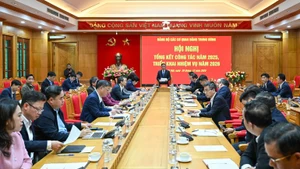“The future will be bright”
Among the 13 kilometres of documents that the National Archives Centre III is preserving, there is a substantial collection of original documents related to the takeover and liberation of the Capital on October 10, 1954. This includes various types of photographic and paper documents from the National Assembly, the Prime Minister's Office, the Ministry of Education, the Ministry of Home Affairs, the Ministry of Foreign Affairs, the Ministry of Finance, the Ministry of Health, the Ministry of Agriculture and Rural Development, the Ministry of Transport and Public Works, and the Ministry of Agriculture. These materials also come from photographer Nguyen Ba Khoan, photo collector Dang Tich, Professor Hoang Minh Giam, and musicians Van Cao, Nguyen Duc Toan, and Huy Du.
According to Dr Tran Viet Hoa, Director of the Centre, there are documents about the Dien Bien Phu Victory and the Geneva Agreement stipulating that French troops would withdraw from Hanoi within 80 days, as well as the government’s preparations for implementing the agreement. This includes documents related to the preparation for taking over Hanoi, such as programmes, plans, and personnel for the takeover of the Capital and establishing the Hanoi Administrative Committee.
In addition, there are reports and representative images regarding the situation of taking over Hanoi. A report from the Hanoi Commanding Committee about the reception of the troops and government on October 10, 1954, stated: “The people at the city gates came out to welcome the soldiers; both sides of the sidewalk were crowded with people standing, from the Cau Den Gate up to the Majestic Theatre, there were even more people. Many officials estimated that there were over 200,000 people. Some had never gone to welcome anyone before who came out to welcome the soldiers, like Professor Vinh, Doctor Chinh, and the entire Ham Long Catholic community. An elderly man with five children said: “In my life, today I see the light for the first time; in the future, we will be happy, and my children’s future will be bright...” In government offices and schools, officials and students gathered to welcome the soldiers; students lined up in groups of 200, with officials making up 70-80%, and the labour hamlets contributing about two-thirds, while the population from the outskirts numbered around 40,000 to 50,000 people…”
Celebrating the 70th anniversary of the Capital Liberation Day (October 10), the centre has been introducing archival documents about the takeover of the capital city, featuring an exhibition entitled “Hanoi - Memories of the Days of Takeover,” which opened on October 2 at the Exhibition House at 61 Trang Tien Street.
 |
| The Capital Regiment led the way, arriving at Hang Gai Street on October 10, 1954, during the takeover of the Capital. (Photo: NGUYEN BA KHOAN) |
From those who have just passed through the disaster...
Dr. Tran Viet Hoa also mentioned that the photos by photographer Nguyen Ba Khoan are among the largest collections of photographic documents that the Centre is managing, particularly the images related to the Capital’s Liberation Day. The Centre has selected over 20 original photos from hundreds of images of Hanoi to be presented to the public.
During the 60 days and nights of fighting in the Capital (December 19, 1946, to February 17, 1947), as a reporter for the ‘Cuu Quoc’ (National Salvation) Newspaper, photographer Nguyen Ba Khoan (1917-1993) bravely ventured to various fronts, along with the soldiers of the national defence forces, to capture the heroic fighting images of our military and people against a powerful enemy. One of the famous works he took during this time is the photo of fallen soldier Tran Thanh, a member of the Hoang Dieu National Youth Rescue Team, embracing a three-pronged bomb and ready to charge at enemy tanks in the Inter-zone I battlefield. This photograph has become a symbol of the Capital's resistance. Journalist Dieu An, the eldest daughter of Nguyen Ba Khoan, was moved to tears, recalling those who had just gone through the disaster that resulted in over 2 million deaths from starvation. They were poor farmers and workers, but they had the determination to liberate the nation because “there is nothing more precious than independence and freedom”. Therefore, they were willing to sacrifice themselves. “This is my father’s photograph, which evokes deep emotions in millions. The figure of the fallen soldier, willing to sacrifice for the Fatherland in the photograph, has been shaped into many sculptural works.
Through the images he captured, it can be seen that the soldiers of the Capital Regiment were ready to fight to the last bullet and to sacrifice themselves with explosives and grenades to charge at the enemy. Meanwhile, the people dug trenches in their homes, mobilised everything they could to build barricades on every street, supplied food, ammunition, and medical aid, and even took up arms and swords to fight alongside the soldiers.
The documents and images of our military and people liberating and taking over the Capital have contributed to educating the revolutionary heroic tradition and the nation's history among future generations towards encouraging efforts to build a more civilised and prosperous city.
Preserving these photos is in part thanks to the great efforts of his wife, Dr. Cao Minh Thu, a medic from the Capital Regiment. She purchased all the film, kept them safe, and even enlarged the photos for him. After withdrawing from Hanoi, she carried all his films back to their hometown in Tra Lai Village (Gia Vien District, Ninh Binh) and safeguarded hundreds of valuable film rolls throughout the resistance against the French. She protected them by placing the films in ceramic jars lined with dried banana leaves, with limestone at the bottom to prevent moisture.
















